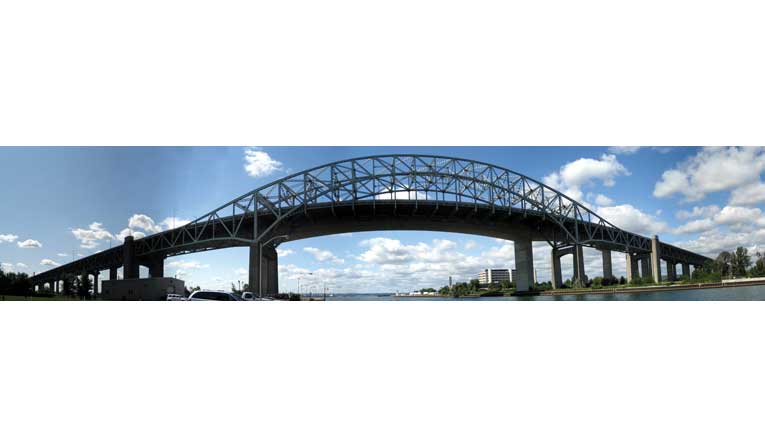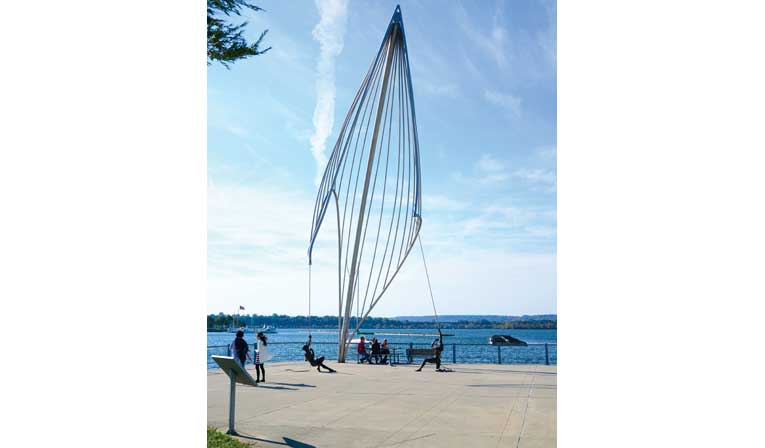Photo by Alexander Synaptic
With the decline of the steel industry, the city of Hamilton, Ontario has reinvented itself — its growth once again built upon having the best natural harbor on the Great Lakes.
Pittsburgh is famous for a lot of things: the Steelers, of course, and its 446 bridges. But the city is perhaps best known for emerging from the ashes of the steel industry collapse, reinventing itself and moving forward to thrive in a new economy.
Today, it is impossible to walk the tree-lined streets of Hamilton, Ontario and not hear the comparisons. Canada’s steel town — affectionately known far and wide as “The Hammer” in a nod to its blue-collar roots — also built its fortunes on the steel industry. Two massive metal conglomerates, Stelco and Dofasco, made Hamilton home, attracted by its railway lines, close proximity to major markets in southern Ontario and the northern U.S., and its large, well-protected natural harbor. From the mid-19th to mid-20th century, most of the city either worked for the steel plants or counted plant employees among its primary customers. The city’s prosperity was such that it formed the nucleus of what was once known as the “Golden Horseshoe” — the affluent, horseshoe-shaped region bordering western Lake Ontario from the Niagara River to Toronto.
But the decline of the North American steel industry hit Hamilton especially hard. With high unemployment, plummeting property values and much of its downtown core boarded up, Hamilton was not exactly the place to be as the steel industry collapsed.
That rough patch, however, marked the beginning of a new era in Hamilton. Dirt-cheap real estate began to attract startup businesses in quest of low overhead costs, as well as commuters and investors who simply couldn’t resist the opportunity to buy large, stately Victorian homes for a fraction of what identical properties sold for in nearby Toronto. These isolated pockets of investment soon began to overlap, bringing new energy and money to the city. Just as that growth began to achieve a critical mass, Hamilton amalgamated with five neighboring municipalities in a move designed to reduce costs. What it did was throw gasoline on a fire, and the city has never looked back.
Hamilton harbor
Nowhere is the rebirth of The Hammer more apparent than in and around its harbor, where marine facilities, growing commerce and new development stand in stark contrast to the old steel mills across the bay.
The city is easy enough to find by boat — just keep traveling west on Lake Ontario until you run out of water. A long sand causeway separates the harbor from Lake Ontario proper and is bisected by a 300-foot wide canal that allows the passage of both recreational boats and commercial ships. The canal is spanned by a two-lane road bridge with 10 feet of clearance, which opens (to 120 feet) every 30 minutes to allow passage by taller vessels. Just beyond the lift bridge, the much larger James N. Allan Skyway also spans the canal some 125 feet up, carrying the majority of vehicular traffic.
Once you clear the canal, you’re in Hamilton Harbour (note the Canadian spelling on your charts) — a miniature lake in its own right, at about four miles long and two miles wide. To your left, the massive Stelco and Dofasco steel mills dominate the horizon. To your immediate right, a large grey building and Coast Guard docks belonging to the Canada Centre for Inland Waters, one of the world’s leading aquatic research facilities. But you want to keep going straight ahead, where a compass heading of 250 degrees will take you across the harbor and directly to the downtown Hamilton marinas.

Photo Public Domain
Charts for Hamilton
Canadian Hydrographic Service Charts
• 2067: Hamilton Harbour
• 2086: Toronto to Hamilton
• 2077: Lake Ontario — Western Portion
US Coast Guard Charts
• 14810: Olcott Harbor to Toronto
To order charts:
Nautical Mind Marine Booksellers and Chart Agents
800-463-9951
nauticalmind.com
Photo by Craig Ritchie
Marine facilities
The majority of Hamilton’s marine facilities for recreational boaters are located on the city’s western end, in the area between Pier 8 and Bayfront Park.
Pier 8, also known as the Centennial Dock, is fairly easy to pick out from the water — look for the apartment buildings on shore and the large building that formally housed the Canada Marine Discovery Centre. Beside it, a warehouse decorated with murals painted by local school children offers another welcoming landmark.
If you turn to port as you approach the Centennial Dock and tuck into the basin at its eastern end, you’ll come face-to-face with the imposing grey outline of HMCS Haida, a WWII Canadian Navy destroyer now preserved as a museum ship. Launched in August 1942, Haida served in Britain during the war, where it performed a variety of patrol and escort duties as part of the 10th Destroyer Flotilla. The ship ultimately sank, or contributed to the sinking, of seven German naval vessels and one U-boat, making it Canada’s most decorated naval ship. Reactivated in 1951, HMCS Haida served two further tours of duty during the Korean War. Today, it’s operated as a museum ship by Parks Canada and is open throughout the summer.
If you turn to starboard as you approach the Centennial Dock, you will see Harbour-West Marina. This full-service marina offers a friendly, relaxing boating experience, whether you are a seasonal customer or just visiting for the weekend.
A stone’s throw further west is Hamilton’s Bayfront Park, which has an excellent double launch ramp for those starting their adventure in town, along with plenty of parking.
The marinas are well situated, offering excellent protection from even the worst late season storms, as well as easy access to downtown Hamilton and its abundant attractions. A 20-minute walk up either Bay Street (mainly residential) or James Street North (primarily commercial) takes you into the downtown core. Or, simply call a cab and you’ll be there in three minutes.
Bright lights, big city
The neighborhood surrounding James Street North — locally known as Jamesville — has been a focal point of Hamilton’s renaissance and is enticingly eclectic. You’ll find an intriguing variety of restaurants, galleries, ethnic grocers and stores, with quite literally something for everyone. Hamilton City Centre, at the corner of James and York, is a large downtown mall with an even more diverse range of shops. Next door, the indoor Hamilton Farmers’ Market — established in 1837 — is open year-round, four days a week, and offers farm-fresh produce and specialty products from more than 70 vendors. Continue walking south along James and you’ll soon come to King Street, one of two major east-west arteries that define the downtown core.
Located on King Street between James and Bay, the Art Gallery of Hamilton, founded in 1914, is Ontario’s third-largest art gallery, with more than 10,000 works in its permanent collection. Nearly 300,000 people visit the gallery each year, some traveling from as far away as Europe or Asia. Almost as large, the McMaster Museum of Art, located at nearby McMaster University, houses more than 7,000 pieces, including historical, modern and contemporary works.
If your taste in art is for the performing kind, you’ll be pleased to learn that Hamilton has quite an active theater scene. Theatre Aquarius, the Players’ Guild of Hamilton and Hamilton Theatre draw the largest crowds, but a growing number of smaller, non-professional companies add to the mix with a range of productions, from classic to quirky.
Prefer live music? You can hear everything from Mozart to punk on any given night. The Hamilton Place Theatre, also known as the Ronald V. Joyce Centre for the Performing Arts, is located right next door to the Art Gallery of Hamilton and is widely considered among Ontario’s finest concert facilities. Performers like Tony Bennett, Leonard Cohen and Heart have lauded its spectacular acoustics.
FirstOntario Centre, a city block away at Bay and York, is the winter home to the Hamilton Bulldogs, the city’s AHL ice hockey team. But in the summer months the venue is booked solid with concerts, hosting local and international artists like John Mellencamp, Rush, Bruce Springsteen, Britney Spears and the Grateful Dead.
Slightly west of the downtown core, the Hess Village neighborhood is where you’ll find many lively bars and restaurants, as well as a wide range of live entertainment. For the latest information on who’s playing where, pick up a free copy of View, a weekly entertainment guide that’s distributed just about everywhere in downtown Hamilton.

Photo by Craig Ritchie
Picture perfect
As you walk around town, you can’t help but notice the incredible architecture. It’s one of the few places on earth where you can find bona-fide Victorian, Gothic revival, mid-century modern, art modern and art deco buildings all within a few blocks. Street after street of Victorian walk-ups speak to Hamilton’s affluent past, while inspiring new construction speaks to its future. But by any measure, the Hamilton Go Centre, on Hunter Street, stands as the city’s architectural crown jewel. The only surviving art deco train station in Canada, this pristine structure was built in 1933 and remains in active use today — both as a commuter train station and as a much-in-demand background for television and film production companies.
That’s the other thing you see as you walk around town — film shoots. As part of its rebirth, Hamilton has capitalized on its diverse architecture, easy access and favorable exchange rate to become a current Hollywood darling, attracting more than 100 television and film productions each year. Its buildings and streets have provided authentic backgrounds for Hollywood films like “X-Men,” “Gone in 60 Seconds,” “Cinderella Man,” “Hairspray,” “The Incredible Hulk” and “Man of the Year.” Keep your eyes peeled, because who you pass on the street could very well be Angelina Jolie or Kevin Spacey.
Sitting on a dock on the bay
Not all of Hamilton’s charms reside in the downtown core, of course; some of the best are located right on the waterfront.
The quickest way to learn about the waterfront is to take an informative sightseeing cruise on either the Hamilton Harbour Queen, a 200-passenger tour boat, or the smaller 12-passenger Hamiltonian, both of which dock at Pier 8.
Local businessman Albert Samee purchased the Hamilton Harbour Queen from the waterfront trust in April 2015 after learning that scrapyard owners were bidding on her — a fate he couldn’t bear to imagine. After extensive renovations, the beloved cruise boat has become one of the best local attractions in the city.
Most of the Hamilton waterfront is served by a trolley, which takes about 80 minutes to do its loop. Start at Pier 8 near Williams Fresh Café and gain a shoreside look at all the highlights.
If you’re itching to stretch your legs after a long spell on the boat, the Hamilton Harbour Waterfront Trail begins at Bayfront Park and continues west for about three miles, offering a scenic and enjoyable route for walking, running, cycling or inline skating. If you’re feeling particularly energetic, this path connects to the Waterfront Trail, an 870-mile multi-use route that follows the Canadian shorelines of the Great Lakes and St. Lawrence River all the way from Lake St. Clair to Quebec.
The festive type
Hamilton is home to a number of different festivals each year, many of them held on or near the waterfront. The Totally British Festival gets things rolling in mid-May, followed by the Hamilton Music Awards and Festival later the same month. The International Guitar Festival takes center stage in late June, followed by the Because Beer Craft Beer Festival in early July.
Because one beer is usually followed by another, people in Hamilton feel one beer festival should be followed by another, too. So mark mid-August on your calendar for the Hamilton Beer Festival, followed by Port Days to the waterfront, with free, nautically-themed activities including tall ships, entertainment, food and more. Hamilton’s Festival of Friends, also held in August, is a fun-filled, three-day music festival that draws big-time acts and more than 250,000 visitors. The James Street Supercrawl, held in early September, celebrates the diversity of the Jamesville district with free art, music and more.
Farther afield
With its population of 520,000, Hamilton ranks as Ontario’s third-largest city. While much of downtown Hamilton is easily walkable, some of the city’s attractions will require a short cab ride from the marinas. The Canadian Football Hall of Fame, on Main Street between Bay and McNab, is a popular museum celebrating Canada’s gridiron heritage. If you’re a real fan of the game, visit in late summer when you can catch the Hamilton Tiger Cats in action at a Canadian Football League pro game on Tim Horton’s Field.
Located at the Hamilton airport, the Canadian Warplane Heritage Museum houses one of the world’s finest collections of flying historical aircraft, including one of only two airworthy Lancaster bombers in the world. With a focus on Canadian military aircraft, the museum has 36 planes on display in its permanent collection, plus occasional visiting aircraft. Rides in some planes (including the Lancaster and a B-25) can be arranged with a tax-deductible donation.
Stop in at Dundurn Castle where you can experience a guided tour of the 40-room, 18,000 square-foot opulent, neoclassical mansion that was once home to Sir Allan Napier MacNab, former prime minister of Upper Canada. The castle, which is open year-round as an active museum, also offers visitors spectacular views (and scents) of the sprawling kitchen garden.
There’s also plenty to see on the north side of the harbor, in the neighboring city of Burlington. On warm summer weekends, the beach strip on the Lake Ontario side of the Skyway Bridge turns into one big raft party. Onshore, at nearby Spencer Smith Park (between the north end of the beach and the Burlington Pier) you’ll find a wide variety of festivals and events almost every weekend of the summer, including the Sound of Music Festival, the Burlington Beer Festival and Canada’s largest Ribfest.
When visiting Hamilton, the problem isn’t finding things to do — it’s finding enough time to fit them all in. You can’t see it all in one visit, but one visit is all it takes to appreciate what a special place this is. While the city has had its ups and downs, there can be no denying The Hammer has its own kind of appeal.




